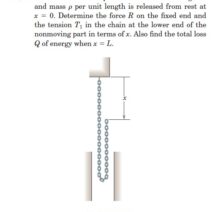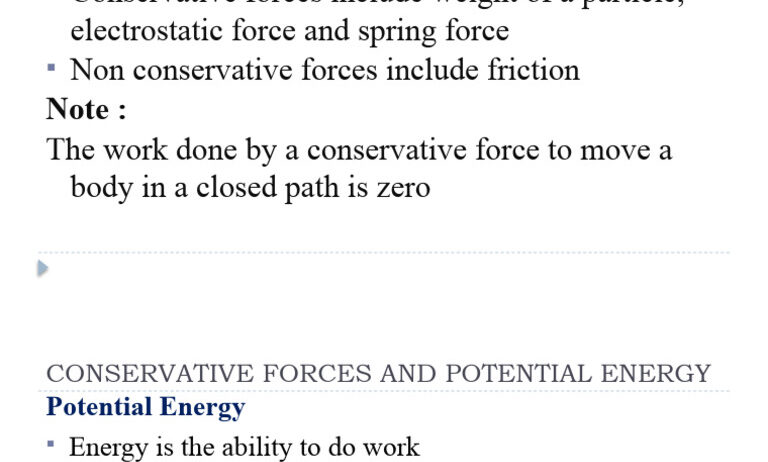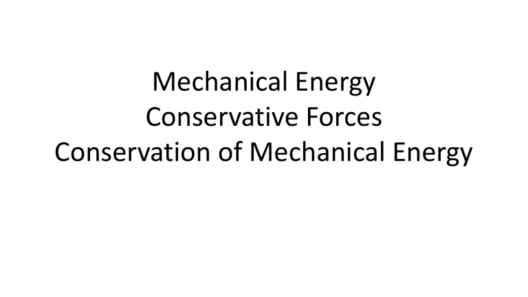The concept of potential energy is a cornerstone in classical mechanics, often invoking intrigue and curiosity. People frequently ponder the nature of forces and their potential energies, leading to the question: Does a force need to be conservative to have potential energy? To answer this inquiry, we must first delineate the characteristics of conservative forces and then explore the relationship between forces and potential energy.
Conservative forces, by definition, are those that possess the unique property of path independence. When a particle moves between two points in a conservative field, the work done by the force depends solely on the initial and final positions, not the trajectory taken. Typical examples of conservative forces include gravitational forces and elastic spring forces. In contrast, non-conservative forces, such as friction and air resistance, do not possess this property. The work done by these forces, rather than simply depending on the endpoints, often varies with the path traversed.
Potential energy is defined as the energy stored within an object due to its position relative to other objects. It is inherently linked to the concept of work done against conservative forces. For example, when lifting an object against gravity, work is done against the gravitational force, and this work is stored as gravitational potential energy. Conversely, if one were to slide an object across a rough surface, friction would convert kinetic energy into thermal energy, dissipating potential energy in a non-conservative manner.
Now, we must explore the criteria that govern potential energy associated with a force. For any force to be associated with potential energy, two primary conditions need to be satisfied: the work done by the force must be path-independent, and there must exist a scalar potential function, V, such that the force can be expressed as the negative gradient of this potential energy function. This scalar function allows for the quantification of energy based on spatial coordinates. However, this leads us to the crucial question: must forces always be conservative to manifest potential energy?
While it is fundamentally true that only conservative forces can have a well-defined potential energy function, potential energy can exist in contexts where forces themselves aren’t purely conservative. The ambiguity often arises in situations where forces have components that behave non-conservatively yet still yield a form of potential energy. A prime example is the behavior of a charged particle in an electric and magnetic field. In electrostatic cases, potential energy is derived from the conservative electric field, yet the presence of magnetic forces complicates the scenario.
In instances involving non-conservative forces, such as friction, potential energy may not adhere to the conventional definitions observed under conservative forces. For example, when a ball rolls down a hill, potential energy is converted to kinetic energy, but the presence of friction would lead to some energy loss as heat, representing a non-conservative scenario. However, in a frictionless environment, all gravitational potential energy can convert seamlessly into kinetic energy, illustrating a strict adherence to conservative principles.
Furthermore, irregularities in potential energy concepts can arise in non-linear systems. Here, unusual forces can be formulated where some potential energy is assigned despite the forces exhibiting non-conservative traits. Reactive forces in some dynamic systems may be indicative of potential energy behaviors through latent energy capture during transient interactions. Such forces, despite their non-conservative nature, provoke interest because they can store energy temporarily, evolving the common understanding of potential energy into more complex terrains of physics.
Interestingly, this leads us to the philosophical implications of energy conservation principles. On a macroscopic scale, the First Law of Thermodynamics straightforwardly states that energy cannot be created or destroyed, merely transformed from one form to another. Thus, in non-conservative forces, the energy lost is not lost in a definitive sense; it is transformed, impacting the way we study energy systems.
The allure of potential energy is also rooted in its practical applications. Engineers routinely exploit the principles of potential energy in various fields, from designing roller coasters using gravitational potential concepts to constructing hydroelectric dams that utilize potential energy in water. These real-world applications are grounded in a rigorous understanding of the interplay between force and energy, reinforcing the significance of differentiating between conservative and non-conservative forces.
In examining the broader implications, one arrives at the conclusion that while all conservative forces are affiliated with potential energy, the reverse isn’t entirely true. Potential energy can be associated with force systems that exhibit both conservative and non-conservative characteristics. The fascination with this subject boils down to the richness and complexity of the physical phenomena underpinning our universe. The interplay between different types of forces, their energy characteristics, and their implications leads to a deeper appreciation of the laws governing the natural world, stimulating the quest for further understanding of energy dynamics.
In summary, the straightforward answer to the question is that while a conservative force is necessary for a force to have a well-defined potential energy function, potential energy concepts can extend into complex domains involving non-conservative elements. As such, the exploration of potential energy offers a kaleidoscopic view of fundamental physics, encouraging continued inquiry and a profound respect for the intricate web of forces shaping our reality.








